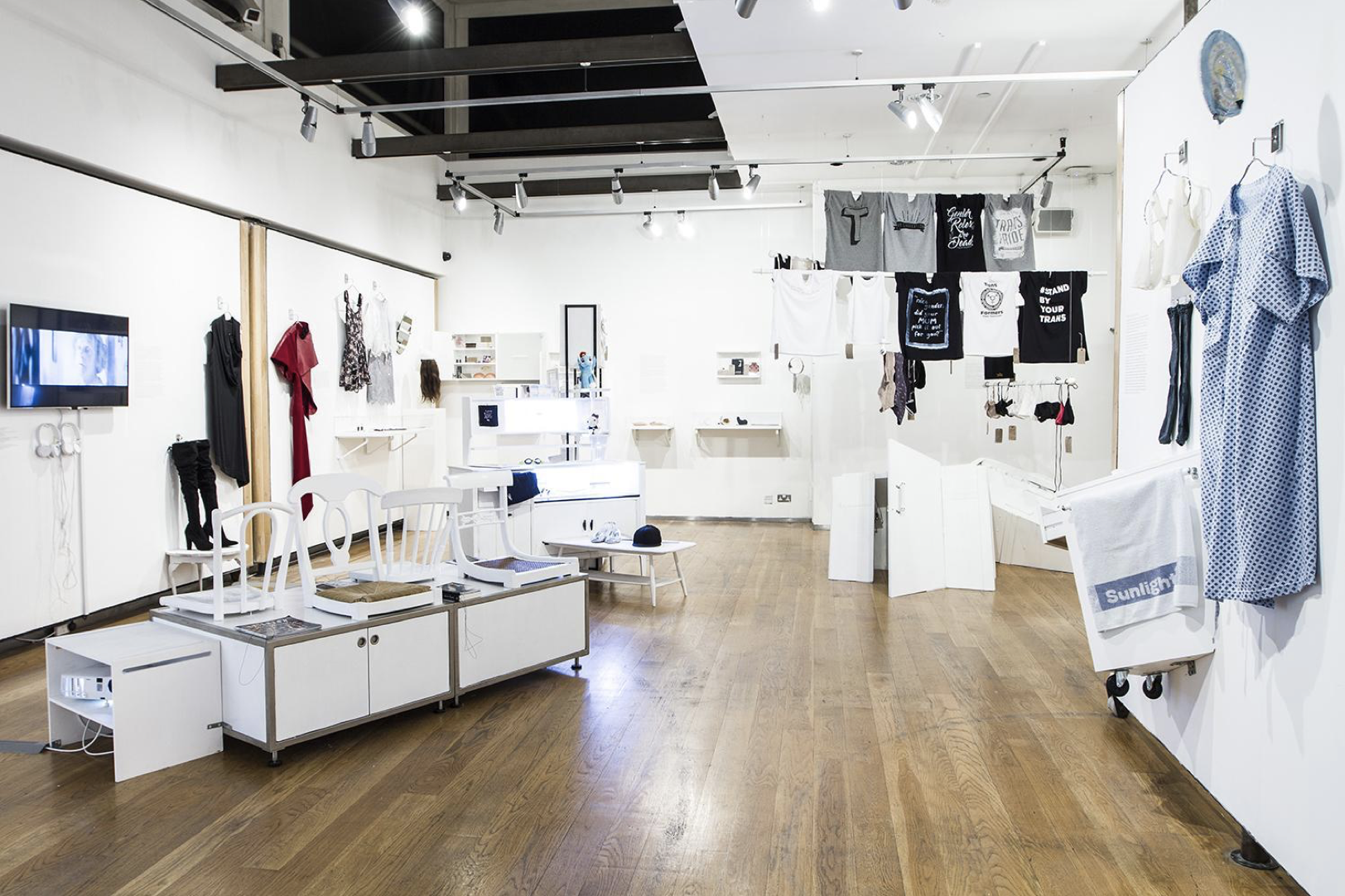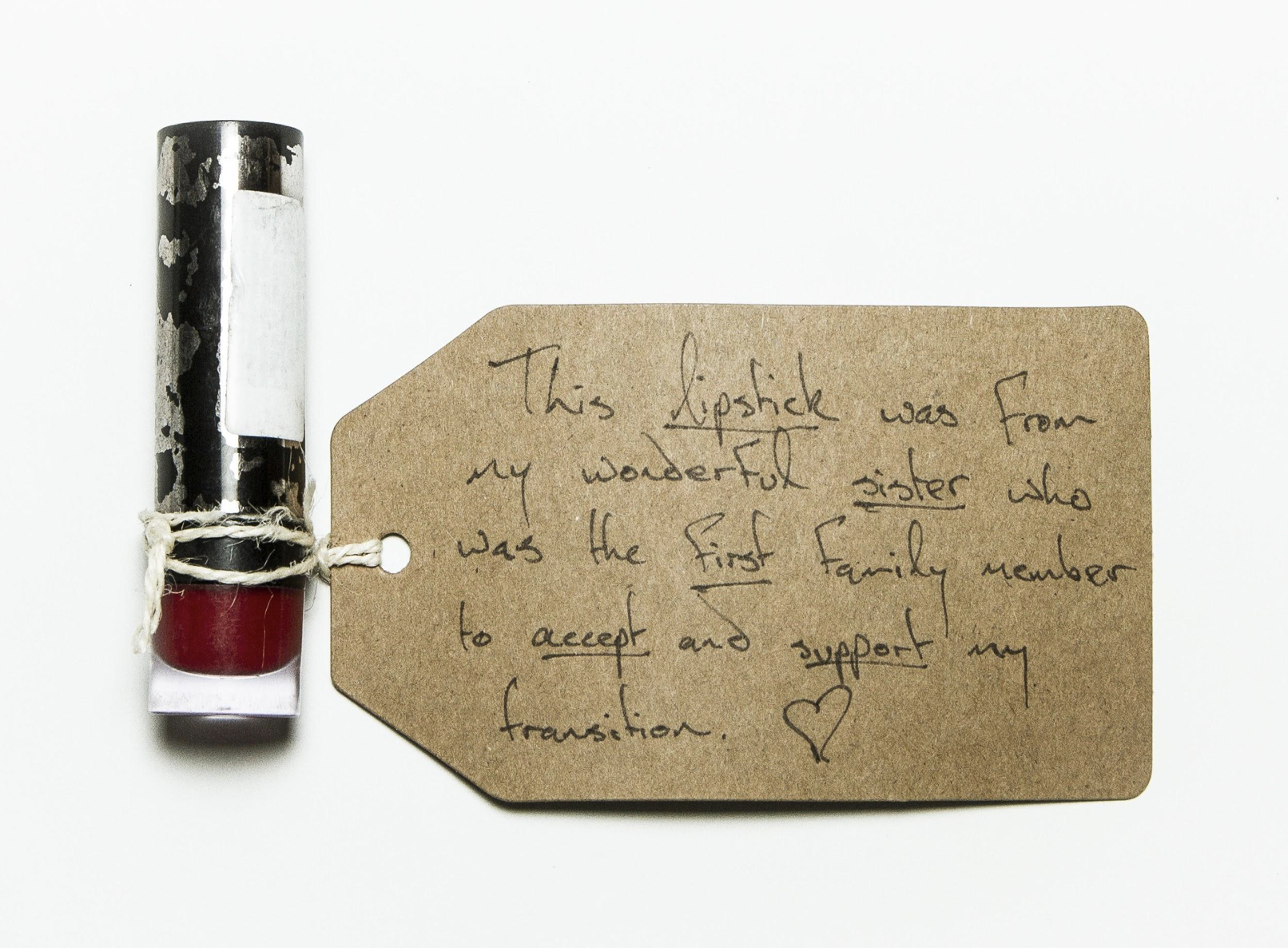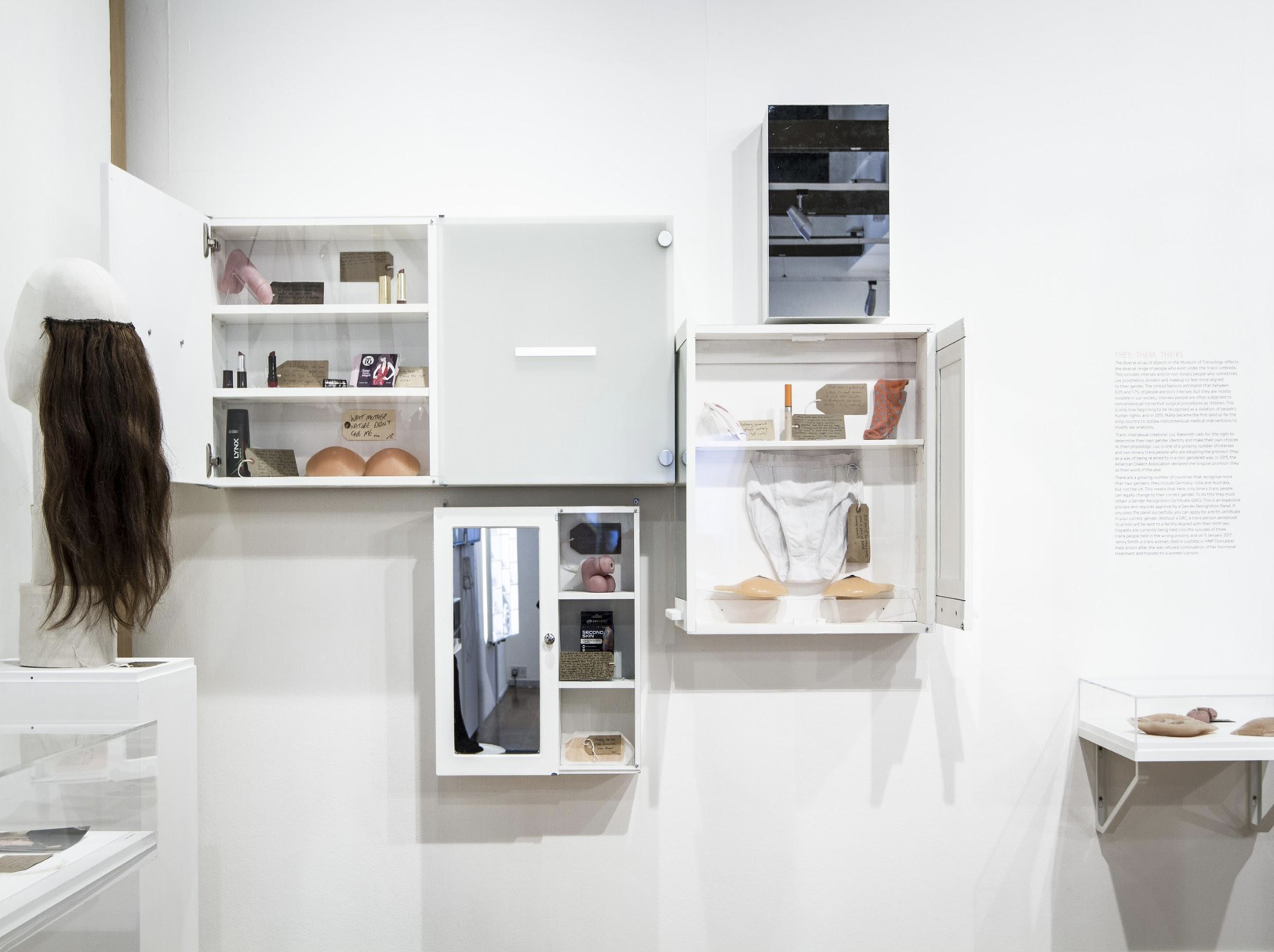Exhibition Review: Museum of Transology
Fashion Space Gallery at London College of Fashion (January 20-April 22, 2017)
“I believe that there are as many gender identities as there are people; all unique, all constantly being explored in conscious and unconscious ways,” wrote Juliet Jacques in her last post of her 2012 Transgender Journey series for The Guardian.[1] Her memoir Trans is one of the many objects included in the Museum of Transology exhibition at London College of Fashion’s Fashion Space Gallery. “The collection is as diverse as the trans experience itself” reads the introductory text, echoing Jacques’ words.
The diverse array of personal stories gathered by curator and fashion historian E-J Scott for the Museum of Transology is mirrored by the variety of artifacts included in the collection, which span from train tickets to books, from prosthetics to garments. The project originally began as Scott’s personal effort to gather an archive of trans stories and artifacts. Transology came to describe the practice of collecting trans-related objects and narratives in order to tell a collective “theirstory.” The collection now holds over 120 artifacts, most of them accompanied by personal anecdotes and autobiographical snapshots —hand-written on paper tags by the owners of the objects. The aim was for the stories to become integral part of the artifacts, acting as provenance but also as inseparable component of the object’s meaning. “It's their voice, it's not overwritten by a cisgender curator. These are real people's lives; real people's experiences; real people's things,” explains Scott. [2]
The objects are organized into sections, each corresponding to a different space: Entrance Hall, Wardrobes, The Bathroom, The Lounge Room, Medical Cabinet, In Hospital. These spaces are, in turn connected to themes. The Entrance Hall includes objects that speak of belonging to trans communities; physical transition is explored through the Medical Cabinet and In Hospital sections; Wardrobes, The Bathroom and The Lounge Room explore gender expression, cosmetics, dress, and intersectional trans identities. Viewers are thus invited to explore everyday spaces of lived trans experience while immersing themselves in powerfully intimate stories. Rather than merely look at trans people through a cisgender gaze we are invited to, pun intended, put ourselves in their shoes. Information on trans people in the U.K. and beyond provide a backdrop for the moving personal narratives. This strategy effectively frames individual experiences within broader socio-political contexts and discourses, thus shedding light on the many issues transgender people still face despite, and sometimes because of, the increased media visibility that TIME Magazine in 2014 called “The transgender tipping point.”[3]
This visibility is contested and reframed in the show through accounts of trans embodiment. The tag on a deodorant stick reads “This was the first ‘boy’ product I bought. It was for a drag king night, and it felt so good ‘dressing as a boy’ and broke down some invisible barrier I had against the ‘boy stuff.’ Opening doors. Smelling great.” A black, worn binder is the silent witness of emotional and physical pain: “This binder hurt so much, but I wore it all day, every day. I was scared of people touching me on the shoulder in case they could feel it underneath. This thing didn’t just crush me, it crushed my soul.”
Even when trans bodies are discussed in the exhibit, the focus remains on lived experiences rather than on the “outcome” which, as the public transition of Caitlyn Jenner showed, tends to be fetishized in “before and after” narratives. Packets and sachets of hormones are displayed in lieu of bodies, while the personal stories complicate the common “wrong body” narrative. “These saved my life in more than one way” reads a tag, while another person speaks of how “emotionally unstable and really depressed” they felt after the first round of Progynova. “IT’S MADE ME THE HUSBAND AND FATHER I ALWAYS WANTED TO BE” reads another tag. These testimonies convey the importance and connectivity of mental health, gender roles and personal aspirations alongside physical changes.
Some of these accounts also question the alleged complicity of trans’ people in re-affirming gender binaries, a narrative vehemently supported by some radical feminists like Janice Raymond and Germaine Greer.[4] A black Vivienne Westwood dress, for instance, was worn by the curator on the occasion of an interview with British artist Grayson Perry ‘to challenge my own perpetuation of binary masculinity.’[5]
Pins, zines and t-shirts also attest to flourishing genderqueer and gender non-binary initiatives, especially among younger demographics. An indicator of this recent shift is the emergence of the singular they/them/their pronoun, which parallels the recognition of more than two genders by countries like India, Australia and Germany. However, it also highlights how the gender binary trans people are sometimes accused of perpetuating is directly connected to the decision by an overwhelming majority of world governments to only allow trans people to legally change to binary gender terms, if at all. This is also the case in the U.K., a reality attested to in the exhibition with a letter from the Queen that confirms the change of gender on the recipient’s passport.
Prosthetics, tucking underwear and binders attest to the necessity for many trans people to “pass” in an attempt to avoid violence, marginalization and bullying. While other objects attest to the feelings of joy and liberation that can come from embracing traditional notions of masculinity or femininity. “I felt that I would not pass with short hair so I went for a full head weave extensions. These extensions marked the beginning of my journey of self acceptance and love <3” reads one tag. Similarly, a pair of eyelash curlers is accompanied by the enthusiastic “Battery powered eyelash curlers for hot curls!”
The exhibition demonstrates that style and appearance are extremely charged for trans people and affect their lives in very concrete, tangible ways. Thus, the show could not avoid exploring how clothes have the ability to become tools for political activism. Many t-shirts worn for Trans Pride and in everyday life become billboards for slogans like “T For Tranny” and “Gender Roles Are Dead” as well as ironic “meta” remarks such as “nice gender, did your mum pick it out for you?” A tag on one of the t-shirts explicitly addresses the importance of sartorial politics: “Fashion meets trans, meets a call to action #Stand/byYourTrans.”
From the political to the personal, to the personal-as-political, the Museum of Transology manages to offer many perspectives on what constitutes the trans experience. Most importantly, it succeeds in presenting trans experiences as an undeniable facet of human experience. These “narratives of hope, despair, ambition, confidence and desire” represent the pluralism of a movement that the mainstream has only now begun to understand.[6] From a more scholarly perspective, the exhibition also points to a gap in fashion museology. As a field, fashion curation has mostly focused on the work of those who create fashion and has only recently, and timidly, engaged with the queer identities of fashion designers.[7] By focusing on the “theirstory” of those who wear the clothes, on the other hand, not only is the Museum of Transology a step forward in fashion’s engagement with queer identities and politics, but it is also a key contribution to the exploration of everyday dress practices in fashion curation.
Notes
[1] https://www.theguardian.com/lifeandstyle/2012/nov/29/transgender-journey-last-post
[2] https://broadly.vice.com/en_us/article/museum-of-transology-ej-scott-curator-interview
[3] http://time.com/135480/transgender-tipping-point/
[4] For a discussion on radical feminist and transfeminism see for instance: https://www.lrb.co.uk/v38/n09/jacqueline-rose/who-do-you-think-you-are
[5] Excerpt from the interview available at: https://www.youtube.com/watch?v=uPtBpV4Kz6w
[6] Museum of Transology, exhibition catalogue.
[7] See for instance the 2013 exhibition A Queer History of Fashion at the Fashion Institute of Technology in New York City.





